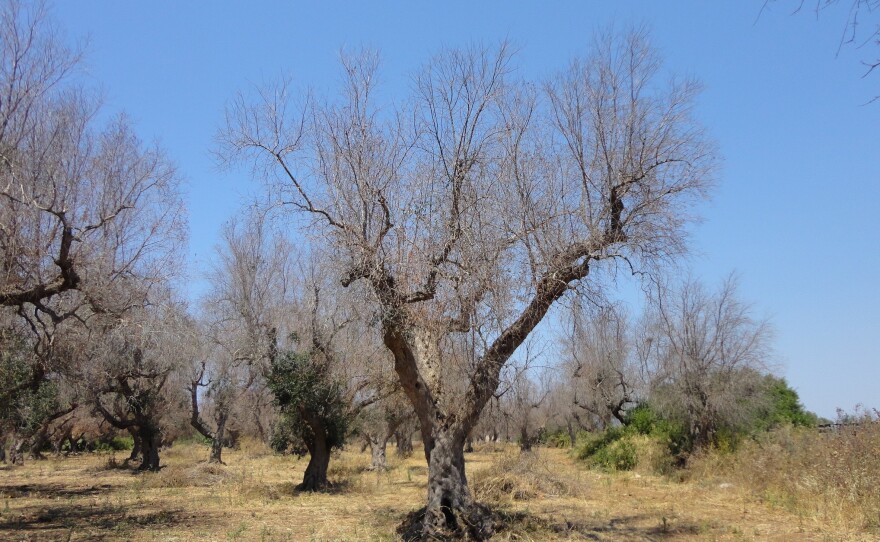Federico Manni first noticed something was wrong with his family's olive trees about six years ago.
It was summer, the cicadas were singing, and Manni and his father, Enzo, were weaving through their olive groves in Puglia, the southern region forming the "heel" of Italy's boot.
They noticed some trees looked burnt.
"Dead branches, brown leaves," Manni says. "Terrible, really terrible."
They pruned and washed the trees but it didn't help. Soon more trees shriveled. Today nearly all are dead.
The Mannis now call the field worked by generations of their family an "olive-tree cemetery."
"These olive trees survived wars and bad weather. They almost gave us a sense of immortality," Enzo says. "Now I hold back my tears when I see these extraordinary beauties replaced by lifeless trunks."
The tree-killer is a bacterium called xylella fastidiosa. Since 2013, it has killed millions of olive trees in Italy and is now threatening those in Spain and Greece. Together, these countries produce 95% of Europe's olive oil. A recent study projects that southern Europe, already crushed by the coronavirus pandemic, could lose at least $22 billion over the next 50 years, if xylella spreads.
"There is no cure," says Maria Saponari, a plant virologist at the Institute for Sustainable Plant Protection in Italy, "and the disease spreads quickly."
Saponari compares xylella to the coronavirus. Just as COVID-19 keeps oxygen from reaching our vital organs, she says, xylella clogs the inside of olive trees so they can't absorb water.
"On the outside, you see the leaves desiccate, you see the wood turn gray or brown, and the tree dies," she says.
Saponari, who has studied xylella for years, says the bacterium came to Italy from the Americas, where it ravaged citrus trees and vineyards. She says Italy likely imported ornamental coffee plants infected with xylella. Because it flourishes in warm weather, "unfortunately it found a very suitable condition to establish here," she says.
The pathogen is spread by sap-sucking insects like the spittlebug. Because there's no cure, Saponari says farmers must focus on prevention, which includes keeping spittlebugs away from trees. One method involves weeding and tilling olive groves to kill insect larvae. Scientists have also suggested trying insect-repelling clays.
Olive farmers in Puglia have tried it all. They have cleaned infected branches with copper sulphate and fertilized the soil with cow manure. They have quarantined sick trees and uprooted healthy ones nearby.
But Gianni Cantele, a winemaker, who is part of the local farmers association, says the supply of olive oil has nearly run dry.
"The production in this area is no more than 10% of the original," he says.
Cantele says that the disease has also hurt local tourism built around those olive trees.
"We lost a huge historical and cultural treasure," he says. "Olive trees define the landscape here."
In Spain, xylella has mainly affected almond trees and vineyards. But Blanca Landa, a plant pathologist at the Spanish National Research Council's Institute for Sustainable Agriculture, warns Spain's olive farmers to stay vigilant.
"You never know what can happen," she says, if farmers import unvetted plants and "introduce something that can be really dangerous and destroy completely the economy of a country."
"If I drive through Andalusia (in southern Spain), I cannot imagine not seeing olive trees there," she says. "Olive oil is on every table. Olives are offered to visitors in every home."
Xylella has so far spared Greece. "But we are all on high alert," says Antonis Marakakis, head agronomist for olive farmers at Terra Creta, an olive-oil company on the island of Crete.
He tells farmers to call him immediately if their trees look sick.
"I tell them to get samples from the trees so they can be tested right away for signs of xylella," he says. "We have to catch it before it spreads."
Back in southern Italy, Federico and Enzo Manni are now struggling to farm potatoes during a pandemic.
Federico shares old videos of the family harvesting and pressing olives into earthy, slightly spicy olive oil, before xylella turned their trees into scorched-gray corpses.
"When we lost the trees," he says, "it's like we lost our house."
He says he hasn't given up on olives just yet.
Xylella infects the two best-known olive varieties in Puglia — Cellina di Nardò and Ogliarola salentina — but scientists believe other varieties might be resistant to the disease.
Manni wants to try farming those.
"If we plant 20% of what we lost, it's a good number," he says. "Olives are our story here, and this story is not over."
Copyright 2020 NPR. To see more, visit https://www.npr.org.






